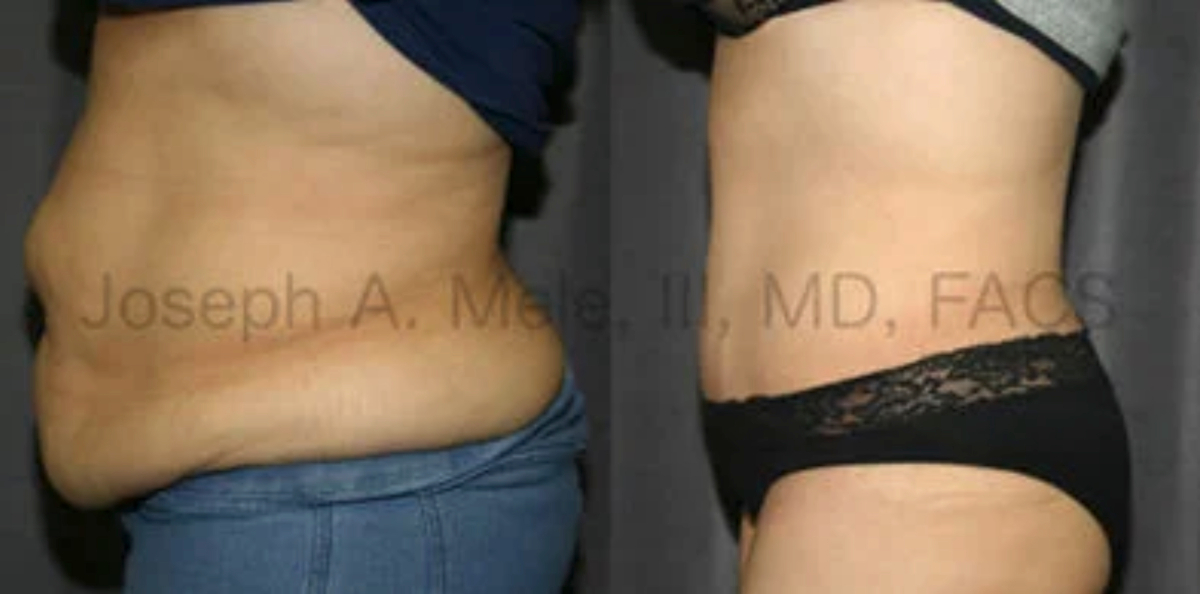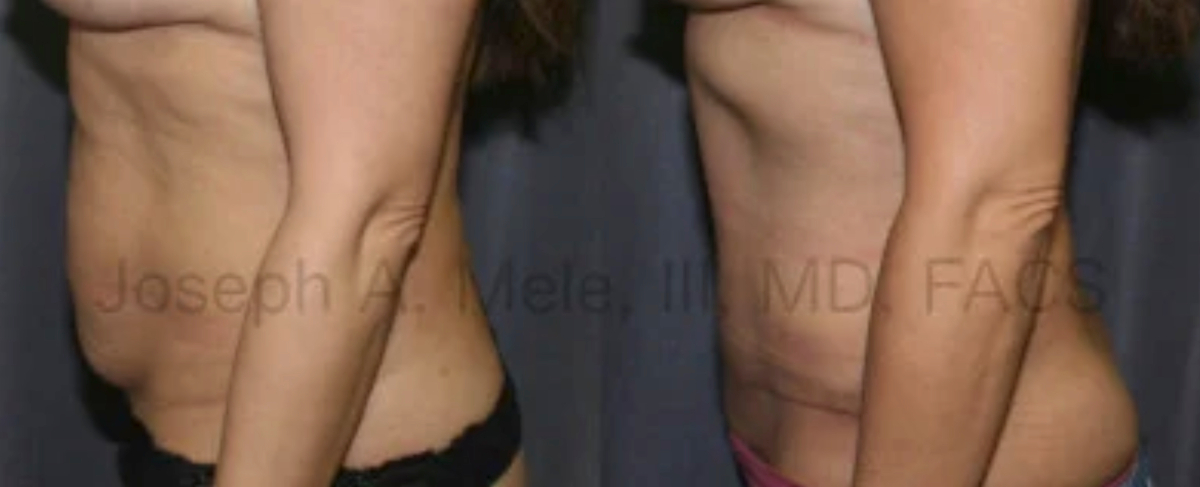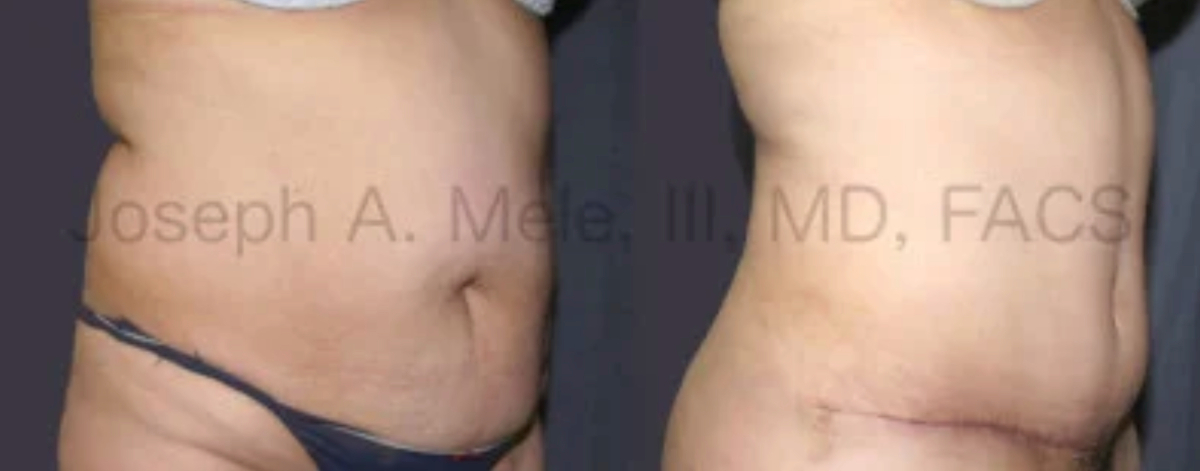The Tummy Tuck remains one of the most frequently requested cosmetic plastic surgery procedures. If you are considering Abdominoplasty, here is what you need to know.
What You Need to Know About Tummy Tucks
Today, we discuss the details of Abdominoplasty. I’ll review the goals, types, methods, recovery, risks, benefits and costs of Tummy Tucks. There is a lot to know before making the decision, but this post gives you a head start in the process.

Tummy Tuck Before and After pictures show improvement in skin, fat and muscle tone.
The Tummy Tuck is designed to improve the appearance of the abdomen. It is particularly useful after weight loss including after pregnancy. Below, I have listed some key points you should know when considering Abdominoplasty:
The Goal of Tummy Tuck
Aesthetics: Abdominoplasty removes excess skin and fat from the abdomen, tightens the abdominal muscles, and can improve the overall contour of the midsection.
- After Weight Loss: Tummy Tucks are common among individuals who have experienced significant weight loss and are left with loose sagging skin.
- Postpartum: Abdominoplasty is often sought by women post-pregnancy to restore the pre-pregnancy shape of the abdomen. Not only are excess skin and fat removed, but the abdominal muscles are also tightened.
Types of Abdominoplasty

Diastasis repair was key for my patient shown above. She had minimal fat, moderate skin laxity and a large bulge from muscle separation. Addressing all three reveals her freakishly flat tummy.
There are several types of Abdominoplasty. The most common is the “traditional” Full Tummy Tuck, but four variations are listed below from most to least extensive. In general, the operative time, duration of recovery and tightening decrease as we move down the list.
- Fleur-de-Lis Tummy Tuck: Useful for massive skin redundancy seen with very large weight loss. Two incisions are made with this technique. The traditional low incision below the belt line and a midline incision from ribcage to pubis to remove the horizontal skin laxity of the upper abdominal wall.
- Full Abdominoplasty: The Traditional Tummy Tuck involves a low incision from hip to hip to remove excess skin and tighten muscles. An incision is also placed around the navel to maintain its position and prevent it from being removed with the skin.
- Floating Belly Button Tummy Tuck: Is closer to a Mini Tummy Tuck than the Complete Tummy Tuck described above. An incision is placed low to remove excess skin. No incision is made around the umbilicus. Instead, the belly button slides down the abdomen with the skin. This helps remove small skin redundancies above the belly button, but cannot be move too far without causing aesthetic concerns. Full muscle tightening is possible with this approach.
- Mini Abdominoplasty: Selectively targets the lower abdomen below the navel. Because patients selected for this procedure have less redundant skin the incision is often smaller and less extensive muscle tightening is performed. The procedure can be coupled with Liposuction to improve the overall aesthetics and proportions. However, if tightening is necessary above the belly button, this is not the best choice.
Tummy Tuck Commonalities

Scar placement is key. A low scar is hard to see. This scar is fresh and will fade with time. Liposuction was also used to contour the back and sides.
All four variations for Tummy Tucks have the following in common:
- General Anesthesia is typically used to provide maximum comfort, safety and predictability.
- An incision is needed to remove excess skin and fat, and to provide access for tightening the abdominal muscles
- An incision is made around the navel to maintain its position in the Fleur-de-Lis and Full abdominoplasties, but not for the Floating Belly Button or Mini Abdominoplasty.
- All incisions are sutured under the skin with absorbable stitches, and drainage tubes may be placed to prevent fluid buildup between the muscle and the skin.
Tummy Tuck Recovery
Hospital Stay: May require an overnight stay or can be an outpatient procedure.
Downtime: Generally requires 1-2 weeks off work, with full recovery taking several weeks to months.
Post-Op Care: Includes wearing a compression garment, avoiding strenuous activities, and managing pain with medication.
Abdominoplasty Risks and Benefits
There are risks to everything we do. Your Board Certified Plastic Surgeon will review the goals and limitations of the Tummy Tuck during your consultation appointment. Common surgical risks include: infection, bleeding, scarring, and reactions to anesthesia. Specific complications for Abdominoplasty include: poor wound healing, skin loss, numbness, and fluid accumulation.
Tummy Tuck benefits are both aesthetic and functional. Aesthetic benefits include: enhanced abdominal contour and improved body image.
Functional benefits may include: improved posture and alleviated back pain caused by weakened abdominal muscles.
Who is a Good Candidate for Tummy Tuck?
Qualities of a good candidates for for Abdominoplasty include:
- healthy individuals
- stable weight
- realistic expectations
- non-smokers
- absent medical conditions that can impair healing
How Much Does a Tummy Tuck Cost?
A quality Tummy Tuck can be expensive and is not often covered by insurance. The cost includes the surgeon’s fee, anesthesia fees, surgery center fees, overnight costs, nursing fees and garments. In California the price ranges from $5000 to $20000, but is dependent on the extent of abdominoplasty, experience of the surgeon and region.
Additional expenses should be expected for prescription pain meds, antibiotics, anti-nausea meds, stool softeners, scar creams, silicone sheeting and time off of work.
Abdominoplasty Consultation
Consult an experienced and Board Certified Plastic Surgeon. It’s crucial to discuss your goals, medical history, and any concerns with a qualified plastic surgeon to determine if Abdominoplasty is right for you. In the San Francisco Bay Area, call (925) 943-6353 to schedule your private consultation.
Previous Post Next Post